Evaluation of Propagation Characteristics Using the Human Body as an Antenna
Abstract
:1. Introduction
2. Simulation Setup
2.1. Human Body Model Proposed
2.2. Simulation Setup for Four Scenarios
2.3. Simulation Setup for the Influence of Electrode Position
2.4. Simulation Setup for the Influence of Distance between Electrode and Human Body
3. Experimental Setup
Experimental Scenario
4. Results and Analysis
4.1. Propagation Characteristics of Different Scenarios
4.1.1. The Channel Gain of Four Scenarios in the Frequency Range from 1 MHz to 90 MHz
4.1.2. The Comparison of Four Scenarios at 44 MHz
4.1.3. Electric Field Distribution of Different Distances at 44 MHz
4.2. Investigation on the Influence of Human Tissues
4.3. Investigation on the Influence of Electrode Position
4.4. Investigation on the Influence of Distance between Electrode and Human Body
4.5. Discussion
5. Conclusions
Acknowledgments
Author Contributions
Conflicts of Interest
References
- Moore, S.M.; McIntosh, R.L.; Iskra, S.; Wood, A.W. Modeling the effect of adverse environmental conditions and clothing on temperature rise in a human body exposed to radio frequency electromagnetic fields. IEEE Trans. Biomed. Eng. 2015, 62, 627–637. [Google Scholar] [CrossRef] [PubMed]
- Mobashsher, A.T.; Abbosh, A.M. Artificial human phantoms: Human proxy in testing microwave apparatuses that have electromagnetic interaction with the human body. IEEE Microw. Mag. 2015, 16, 42–62. [Google Scholar] [CrossRef]
- Ferikoğlu, A.; Çerezci, O.; Kahriman, M.; Yener, Ş.Ç. Electromagnetic absorption rate in a multilayer human tissue model exposed to base-station radiation using transmission line analysis. IEEE Antennas Wirel. Propag. Lett. 2014, 13, 903–906. [Google Scholar] [CrossRef]
- Ibrani, M.; Ahma, L.; Hamiti, E. Assessment of the exposure of children to electromagnetic fields from wireless communication devices in home environments. IET Commun. 2014, 8, 2222–2228. [Google Scholar] [CrossRef]
- Kibret, B.; Teshome, A.K.; Lai, D.T.H. Cylindrical antenna theory for the analysis of whole-body averaged specific absorption rate. IEEE Trans. Antennas Propag. 2015, 63, 5224–5229. [Google Scholar] [CrossRef]
- Chrissoulidis, D.P.; Laheurte, J.M. Radiation from an encapsulated Hertz dipole implanted in a human torso model. IEEE Trans. Antennas Propag. 2016, 64, 4984–4992. [Google Scholar] [CrossRef]
- Vallauri, R.; Bertin, G.; Piovano, B.; Gianola, P. Electromagnetic field zones around an antenna for human exposure assessment: Evaluation of the human exposure to EMFs. IEEE Antennas Propag. Mag. 2015, 57, 53–63. [Google Scholar] [CrossRef]
- Gabriel, C.; Gabriel, S.; Corthout, E. The dielectric properties of biological tissues: I. Literature survey. Phys. Med. Biol. 1996, 41, 2231–2249. [Google Scholar] [CrossRef] [PubMed]
- Gabriel, S.; Lau, R.; Gabriel, C. The dielectric properties of biological tissues: II. Measurements in the frequency range 10 Hz to 20 GHz. Phys. Med. Biol. 1996, 41, 2251–2269. [Google Scholar] [CrossRef] [PubMed]
- Gabriel, S.; Lau, R.; Gabriel, C. The dielectric properties of biological tissues: III. Parametric models for the dielectric spectrum of tissues. Phys. Med. Biol. 1996, 41, 2271–2293. [Google Scholar] [CrossRef] [PubMed]
- King, R.W.P. Electric fields induced in cells in the bodies of amateur radio operators by their transmitting antennas. IEEE Trans. Microw. Theory Tech. 2000, 48, 2155–2158. [Google Scholar] [CrossRef]
- King, R.W.P. Electric current and electric field induced in the human body when exposed to an incident electric field near the resonant frequency. IEEE Trans. Microw. Theory Tech. 2000, 48, 1537–1543. [Google Scholar] [CrossRef]
- Zhu, X.Q.; Guo, Y.X.; Wu, W. Investigation and modeling of capacitive human body communication. IEEE Trans. Biomed. Circuits Syst. 2017, 11, 474–482. [Google Scholar] [CrossRef] [PubMed]
- Chen, X.M.; Pun, S.H.; Zhao, J.F.; Mak, P.U.; Liang, B.D.; Vai, M.I. Effects of human limb gestures on galvanic coupling intra-body communication for advanced healthcare system. Biomed. Eng. Online 2016, 15, 60. [Google Scholar] [CrossRef] [PubMed]
- Callejon, M.; Reina-Tosina, J.; Naranjo, D.; Roa, L.M. Measurement issues in galvanic intrabody communication: Influence of experimental setup. IEEE Trans. Biomed. Eng. 2015, 62, 2724–2732. [Google Scholar] [CrossRef] [PubMed]
- Amparo Callejon, M.; Reina-Tosina, J.; Naranjo-Hernandez, D.; Roa, L.M. Galvanic coupling transmission in intrabody communication: A finite element approach. IEEE Trans. Biomed. Eng. 2014, 61, 775–783. [Google Scholar] [CrossRef] [PubMed]
- Kibret, B.; Seyedi, M.; Lai, D.T.; Faulkner, M. Investigation of galvanic-coupled intrabody communication using the human body circuit model. IEEE J. Biomed. Health Inform. 2014, 18, 1196–1206. [Google Scholar] [CrossRef] [PubMed]
- Hwang, J.H.; Hyoung, C.H.; Park, K.H.; Kim, Y.T. Energy harvesting from ambient electromagnetic wave using human body as antenna. Electron. Lett. 2013, 49, 149–151. [Google Scholar] [CrossRef]
- Simba, A.Y.; Itou, A.; Hamada, L.; Watanabe, S.; Arima, T.; Uno, T. Development of liquid-type human-body equivalent antennas for induced ankle current measurements at VHF band. IEEE Trans. Electromagn. Compat. 2012, 54, 565–573. [Google Scholar] [CrossRef]
- Kibret, B.; Teshome, A.K.; Lai, D.T.H. Characterizing the human body as a monopole antenna. IEEE Trans. Antennas Propag. 2015, 63, 4384–4392. [Google Scholar] [CrossRef]
- Kibret, B.; Teshome, A.K.; Lai, D.T.H. Analysis of the human body as an antenna for wireless implant communication. IEEE Trans. Antennas Propag. 2016, 64, 1466–1476. [Google Scholar] [CrossRef]
- Frederick, D.A.; Jenkins, B.N. Height and body mass on the mating market: Associations with number of sex partners and extra-pair sex among heterosexual men and women aged 18–65. Evol. Psychol. 2015, 13, 113–115. [Google Scholar] [CrossRef]
- Li, J.; Nie, Z.; Liu, Y.; Wang, L.; Hao, Y. Characterization of in-body radio channels for wireless implants. IEEE Sens. J. 2017, 17, 1528–1537. [Google Scholar] [CrossRef]
- Lučev, Ž.; Krois, I.; Cifrek, M. A capacitive intrabody communication channel from 100 kHz to 100 MHz. IEEE Trans. Instrum. Meas. 2012, 61, 3280–3289. [Google Scholar] [CrossRef]
- Xu, R.; Zhu, H.; Yuan, L. Characterization and analysis of intra-body communication channel. In Proceedings of the 2009 IEEE Antennas and Propagation Society International Symposium and USNC/URSI National Radio Science Meeting, North Charleston, SC, USA, 1–5 June 2009; pp. 1–4. [Google Scholar]
- Fang, B.; Yi, W.; Chu, C.; Ying, L.; Na, L.; Liu, K.; Tan, L.; Zhang, S. Creation of a virtual anatomy system based on chinese visible human data sets. Surg. Radiol. Anat. 2016, 39, 441–449. [Google Scholar] [CrossRef] [PubMed]
- Xu, R.; Zhu, H.; Yuan, J. Electric-field intrabody communication channel modeling with finite-element method. IEEE Trans. Biomed. Eng. 2011, 58, 705–712. [Google Scholar] [PubMed]
- Schwan, H.P. Analysis of dielectric data: Experience gained with biological materials. IEEE Trans. Dielectr. Electr. Insul. 1985, 6, 913–922. [Google Scholar] [CrossRef]
- Magill, M.K.; Conway, G.A.; Scanlon, W.G. Robust implantable antenna for in-body communications. In Proceedings of the 2015 Loughborough Antennas & Propagation Conference, Loughborough, UK, 2–3 November 2015; pp. 1–4. [Google Scholar]
- Štumpf, M. Pulsed EM field radiation, mutual coupling, and reciprocity of thin planar antennas. IEEE Trans. Antennas Propag. 2014, 62, 3943–3950. [Google Scholar] [CrossRef]
- Ling, F.; Jin, J.M. Scattering and radiation analysis of microstrip antennas using discrete complex image method and reciprocity theorem. Microw. Opt. Technol. Lett. 1997, 16, 212–216. [Google Scholar] [CrossRef]


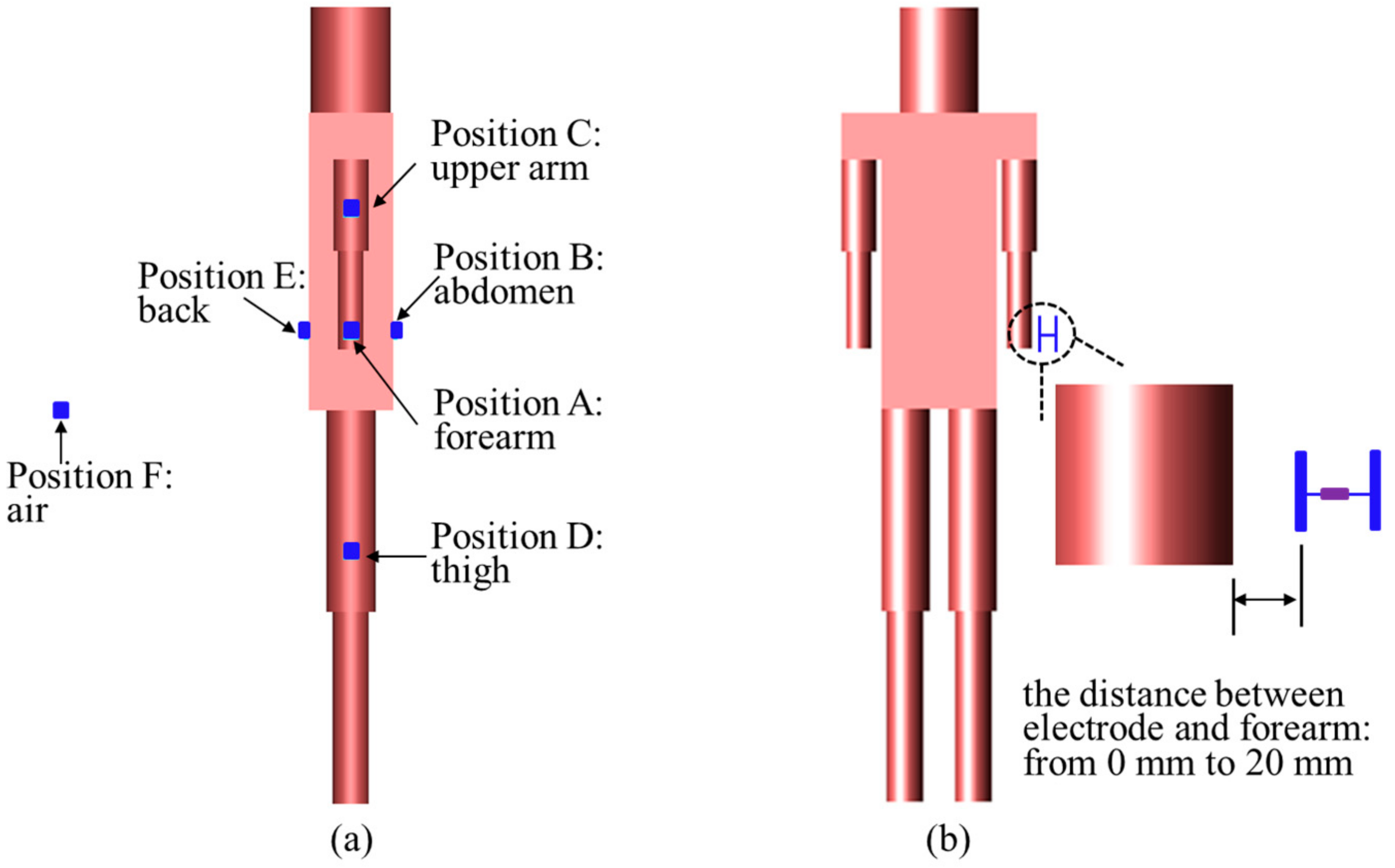
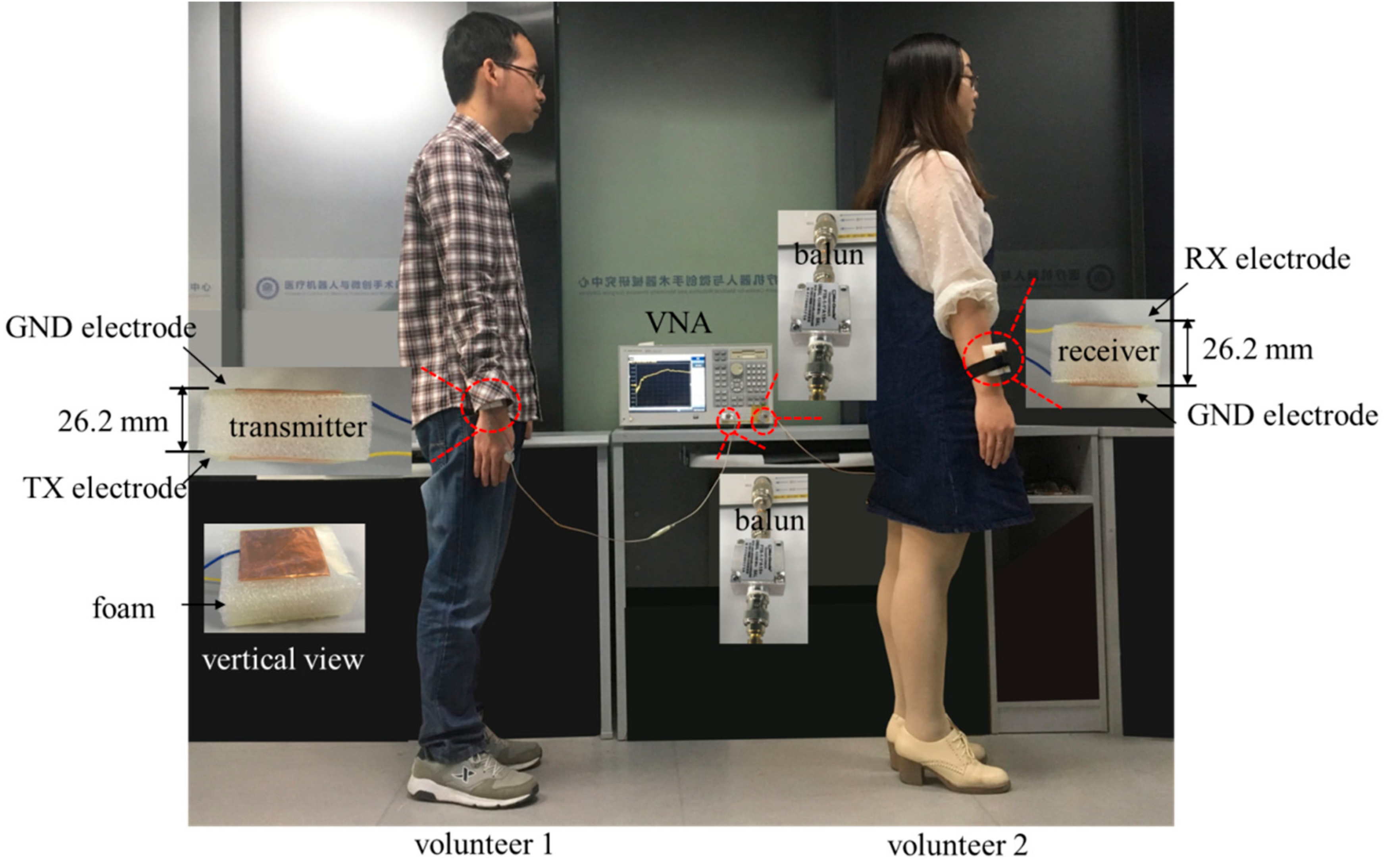

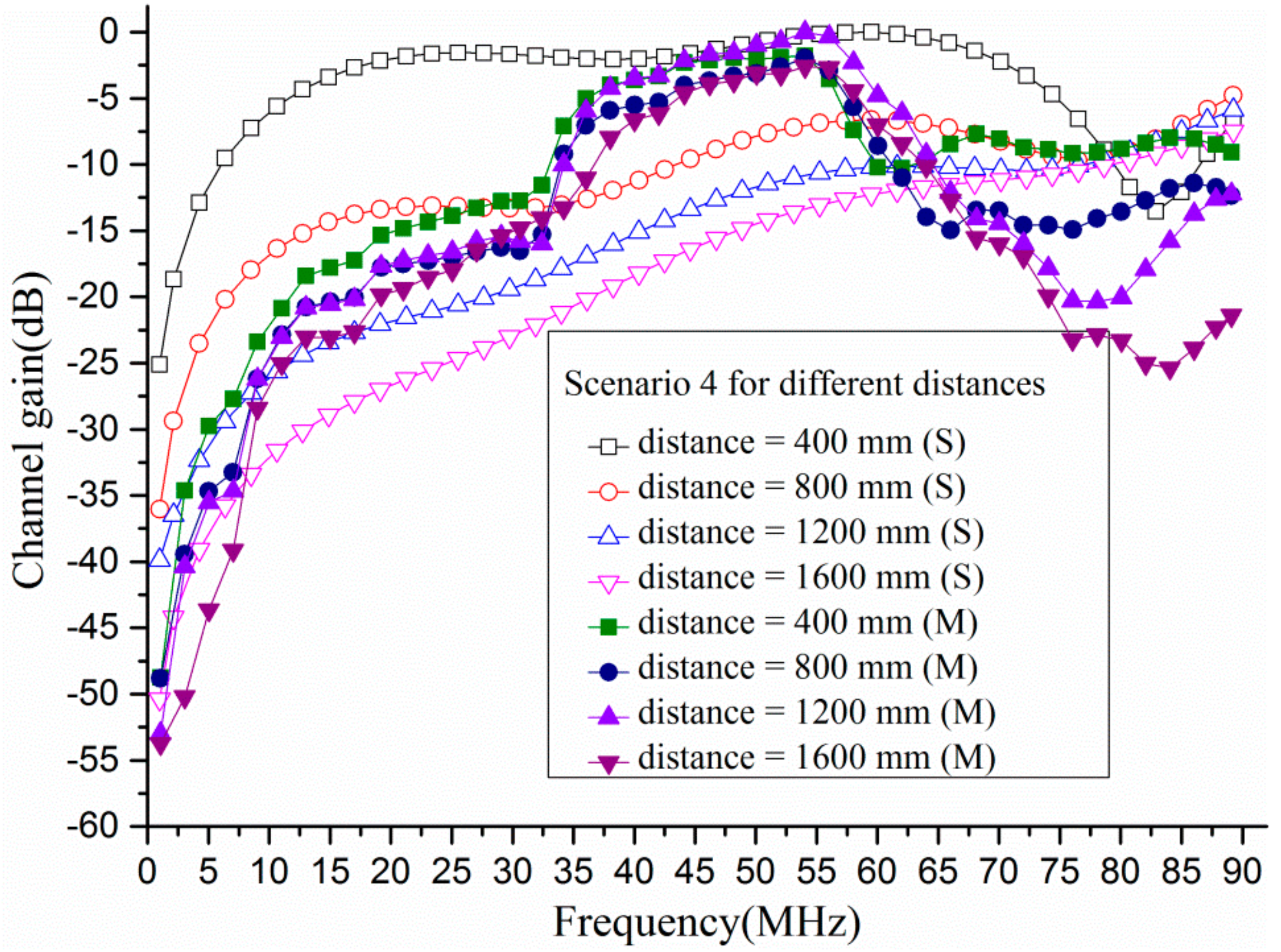
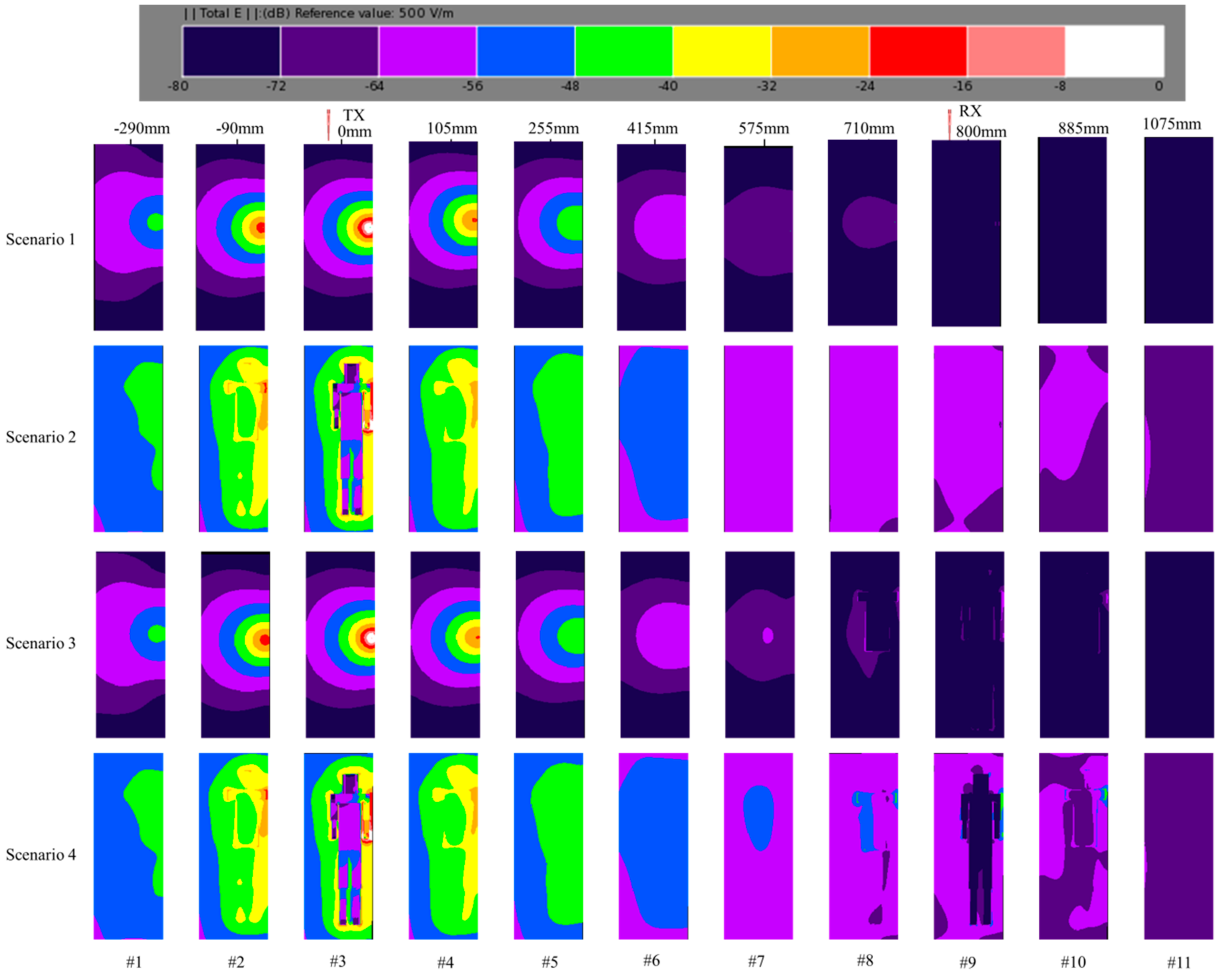

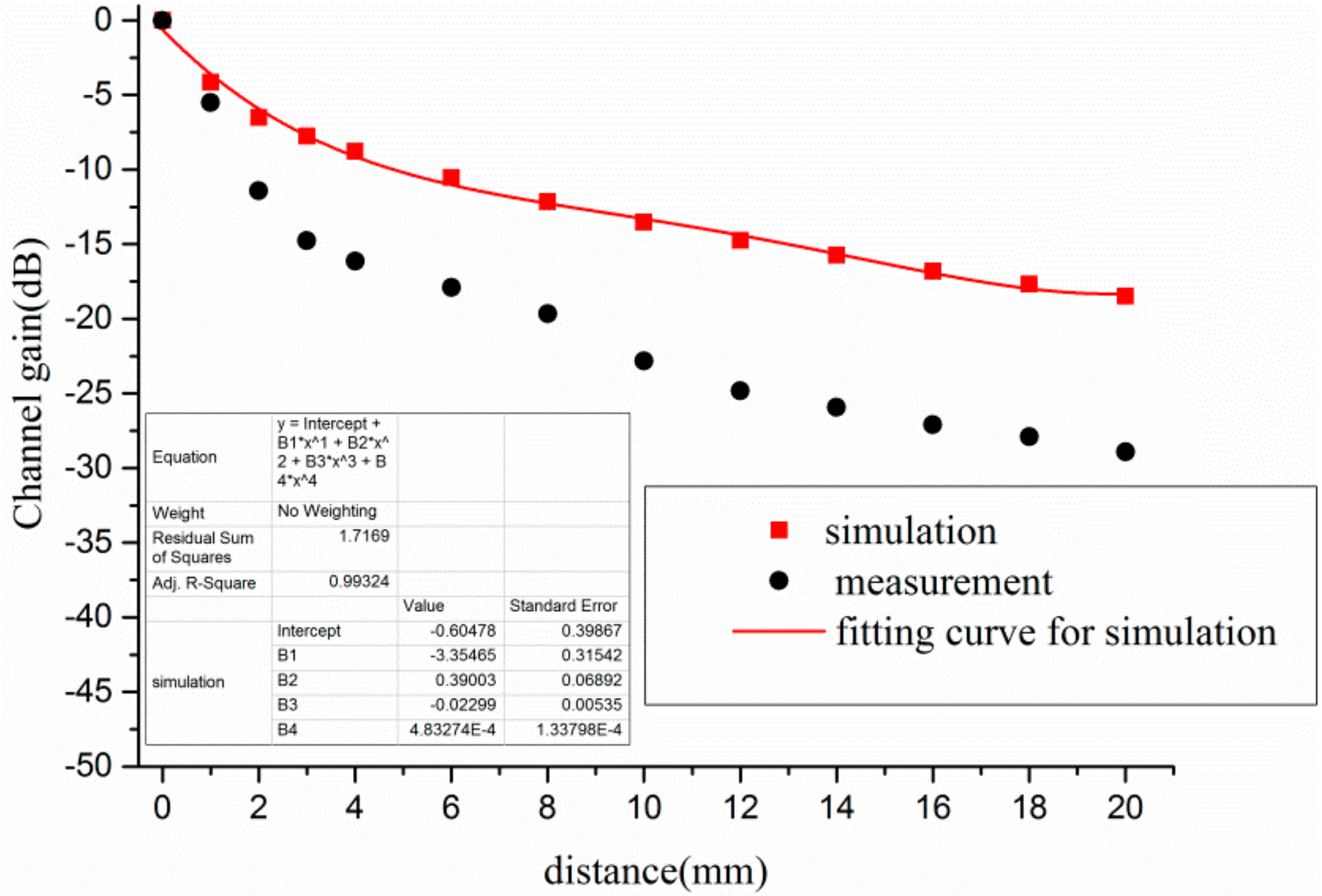
| Body Parts | Skin | Fat | Muscle | Bone | Grey Matter | Heart |
|---|---|---|---|---|---|---|
| head | 4 | - | 9.5 | 20.5 | 51 | - |
| chest | 2 | 4 | 38 | 46 | - | - |
| abdomen | 2 | 7 | 25 | - | - | 56 |
| upper arm | 2 | 6.1 | 20.3 | 9.1 | - | - |
| forearm | 2 | 4.3 | 14.9 | 6.3 | - | - |
| thigh | 2 | 8.8 | 28.7 | 13 | - | - |
| lower leg | 2 | 6.3 | 20.8 | 9.4 | - | - |
| Scenario 1 | Scenario 2 | Scenario 3 | Scenario 4 | |
|---|---|---|---|---|
| input power(W) | 9.22 × 10−6 | 0.0753 | 4.90 × 10−7 | 0.07529 |
| total absorption power (W) | - | 0.05989 | 3.312 × 10−7 | 0.05991 |
| TX absorption power (W) | - | 0.05989 | - | 0.05989 |
| RX absorption power (W) | - | - | 3.312 × 10−7 | 0.00002 |
| accepted power (W) | 4.55 × 10−10 | 6.13 × 10−9 | 6.06 × 10−9 | 2.378 × 10−7 |
| input efficiency | 9.22 × 10−4% | 7.53% | 4.90 × 10−5% | 7.53% |
| accepted efficiency | 4.90 × 10−3% | 8.14 × 10−6% | 1.24% | 3.16 × 10−4% |
| total efficiency | 4.55 × 10−8% | 6.13 × 10−7% | 6.05 × 10−7% | 2.38 × 10−5% |
| Biological Tissue | Skin | Fat | Muscle | Bone | Heart |
|---|---|---|---|---|---|
| relative permittivity | 116.54 | 7.1176 | 80.069 | 18.4 | 124.85 |
| conductivity (S/m) | 0.38954 | 0.034347 | 0.67297 | 0.055928 | 0.63689 |
| Total Efficiency | Skin Model | Fat Model | Muscle Model | Bone Model | Heart Model | Inhomogeneous Model |
|---|---|---|---|---|---|---|
| Scenario 3 | 6.21 × 10−7% | 3.96 × 10−7% | 7.53 × 10−7% | 3.79 × 10−7% | 7.29 × 10−7% | 6.05 × 10−7% |
| Scenario 4 | 2.27 × 10−5% | 3.80 × 10−6% | 4.09 × 10−5% | 3.85 × 10−6% | 3.65 × 10−5% | 2.38 × 10−5% |
| TX Electrode | Air | Air | Air | Air | Air |
|---|---|---|---|---|---|
| RX electrode | forearm | upper arm | thigh | abdomen | back |
| simulation (dB) | 0 | 1.285 | 2.521 | −0.871 | −0.871 |
| measurement(dB) | 0 | −0.110 | −0.308 | −1.295 | −1.035 |
| TX Electrode | Forearm | Forearm | Forearm | Forearm | Forearm | Abdomen | Back |
|---|---|---|---|---|---|---|---|
| RX electrode | forearm | upper arm | thigh | abdomen | back | abdomen | back |
| simulation (dB) | 0 | −0.492 | −1.283 | −1.816 | −1.815 | −1.921 | −1.921 |
| measurement(dB) | 0 | −0.510 | −0.999 | −1.700 | −2.296 | −3.412 | −3.390 |
© 2017 by the authors. Licensee MDPI, Basel, Switzerland. This article is an open access article distributed under the terms and conditions of the Creative Commons Attribution (CC BY) license (http://creativecommons.org/licenses/by/4.0/).
Share and Cite
Li, J.; Nie, Z.; Liu, Y.; Wang, L.; Hao, Y. Evaluation of Propagation Characteristics Using the Human Body as an Antenna. Sensors 2017, 17, 2878. https://doi.org/10.3390/s17122878
Li J, Nie Z, Liu Y, Wang L, Hao Y. Evaluation of Propagation Characteristics Using the Human Body as an Antenna. Sensors. 2017; 17(12):2878. https://doi.org/10.3390/s17122878
Chicago/Turabian StyleLi, Jingzhen, Zedong Nie, Yuhang Liu, Lei Wang, and Yang Hao. 2017. "Evaluation of Propagation Characteristics Using the Human Body as an Antenna" Sensors 17, no. 12: 2878. https://doi.org/10.3390/s17122878
APA StyleLi, J., Nie, Z., Liu, Y., Wang, L., & Hao, Y. (2017). Evaluation of Propagation Characteristics Using the Human Body as an Antenna. Sensors, 17(12), 2878. https://doi.org/10.3390/s17122878






